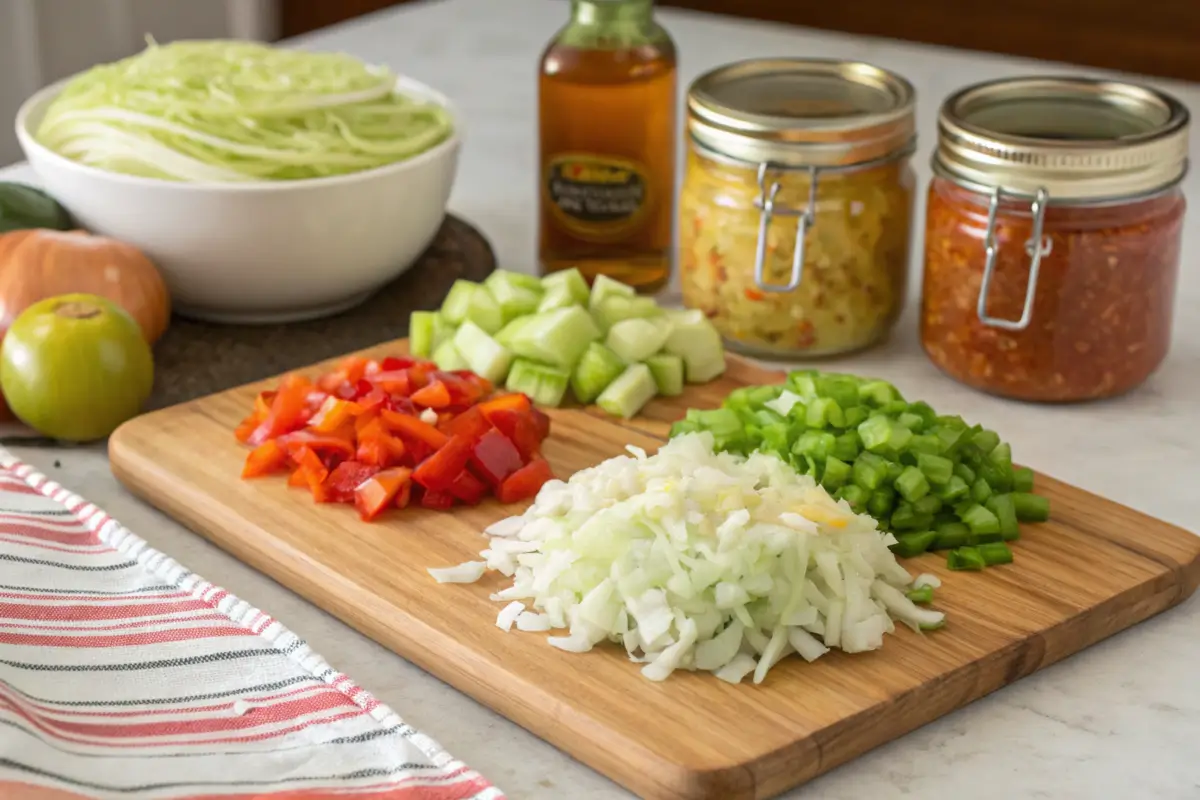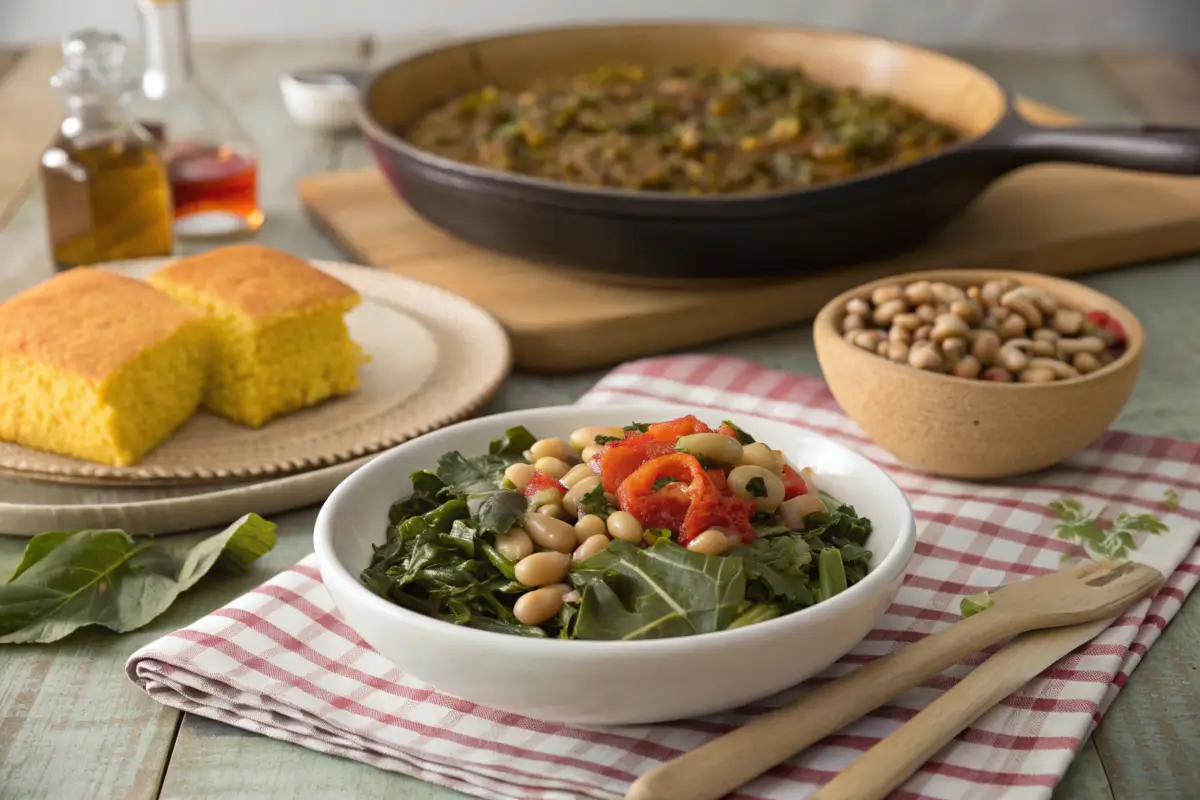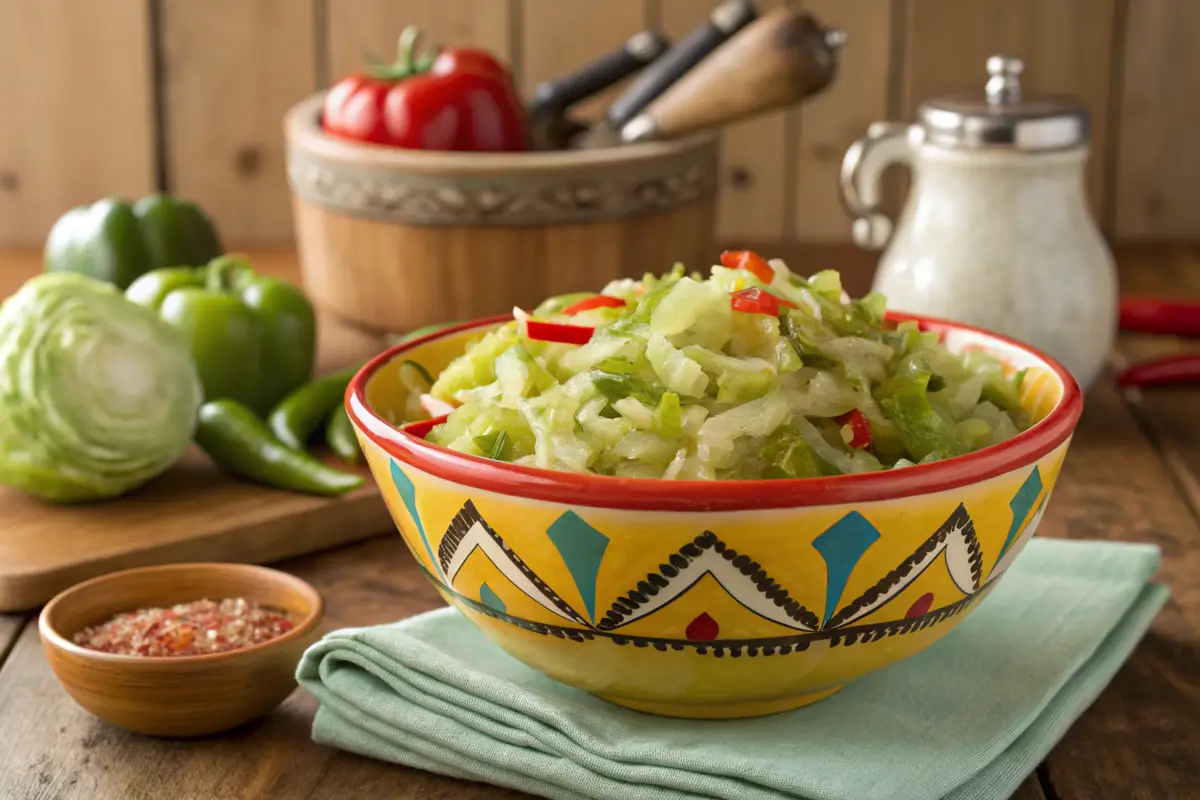Chow Chow, a tangy and flavorful relish, is a cherished staple of Southern cuisine. Renowned for its versatility, this condiment features a delightful blend of pickled vegetables and aromatic spices. In this guide, we’ll explore everything about this beloved relish—its origins, ingredients, preparation methods, and countless ways to enjoy it. Whether you’re curious about its history or eager to try making it at home, this article will walk you through every detail. Let’s dive in and discover why this zesty condiment continues to captivate food lovers everywhere.
Introduction
What is Chow Chow?
This classic pickled relish is made by combining finely chopped vegetables with a tangy, vinegar-based brine. Flavored with a blend of spices, it delivers a distinctive sweet, sour, or spicy kick. While most famously associated with Southern cuisine in the United States, this versatile relish has also gained popularity worldwide, adapting to local ingredients and flavors.
Origins and History
The origins of this relish are somewhat unclear, but most culinary historians trace its roots back to the 18th century. It appears to have been influenced by pickling traditions introduced to America by immigrants from Europe and Asia. The name “Chow Chow” might derive from the Chinese word cha or choy (meaning mixed pickled vegetables) or British pickling practices that gained popularity during colonial times.
In the Southern United States, it became a pantry staple, serving as an ingenious way to preserve excess vegetables like green tomatoes, cabbage, and peppers at the end of the growing season. Every household developed its own recipe, passed down through generations, adding to its rich culinary heritage.
Why It’s Popular
Chow Chow remains a culinary staple not just for its delicious taste but for its versatility. It can be served as a condiment, a topping, or even a side dish. Its bold flavors enhance meals, adding a tangy punch to barbecue, beans, and hot dogs. Plus, it’s a great way to add a touch of homemade goodness to store-bought meals.
With such a rich history and flavor profile, it’s no wonder this humble relish has stood the test of time. Ready to uncover what makes it so special? Let’s explore its ingredients next.
Ingredients of Chow Chow
Key Ingredients in Traditional Chow Chow
At its core, Chow Chow is a vibrant medley of vegetables. The most common ingredients include green tomatoes, cabbage, bell peppers, and onions. These vegetables are finely chopped to create a uniform texture that soaks up the tangy brine. For the brine itself, vinegar serves as the base, lending that signature tangy flavor. Sugar, salt, and mustard seeds are often added to balance the flavors, while turmeric and red pepper flakes bring color and a hint of heat.
If you’re preparing Chow Chow at home, you can experiment with vegetables like green beans, carrots, or even cauliflower for a unique twist. The key is choosing fresh, firm produce that can hold up during the pickling process.
Vegetables Commonly Used
Green tomatoes are arguably the most iconic component of Chow Chow. They provide a slightly tart base that complements the sweet and sour brine. Cabbage adds a crisp texture, while bell peppers contribute a subtle sweetness. Onions, another staple, give the relish a mild, aromatic bite.
For a Southern-style Chow Chow, you’ll also find the inclusion of okra or corn kernels. These regional variations reflect the versatility of the dish, making it an excellent way to use up extra garden vegetables at the end of the season.
Spices and Flavorings
Spices are what transform a simple mix of vegetables into the flavorful relish we know as Chow Chow. Mustard seeds and celery seeds add depth, while turmeric enhances the relish’s golden hue. Some recipes also incorporate ginger, garlic, or dill for a more complex flavor profile. If you prefer a spicy kick, a pinch of cayenne or red chili flakes does the trick.
Regional Variations of Chow Chow
Southern-Style Chow Chow
In the Southern United States, Chow Chow takes on a life of its own. This version often includes green tomatoes, cabbage, and hot peppers, giving it a bolder flavor. Some Southern recipes lean toward the sweet side, incorporating more sugar, while others pack a spicy punch with extra chili flakes or jalapeños. This style of Chow Chow is frequently served as a condiment for barbecue, beans, or cornbread, making it a staple in traditional Southern meals.
Northern-Style Variations
In the northern regions of the U.S., Chow Chow tends to be less sweet and more savory. It’s commonly made with a blend of green tomatoes, onions, and vinegar, focusing on the natural flavors of the vegetables. This style is often used as a topping for sandwiches or mixed into potato salads for a tangy twist.
International Adaptations
This beloved relish has garnered fans far beyond the United States. In Canada, for instance, it often features yellow beans as a key ingredient, giving it a unique flavor and texture. In the Caribbean, you’ll find a spicier, herbaceous version made with scotch bonnet peppers and fresh herbs like thyme, adding a bold twist to traditional recipes.
Although each region brings its own flair, the essence of this relish lies in the balance of fresh vegetables, aromatic spices, and a touch of creativity. Its adaptability and bold flavors make it a favorite across cultures, proving that its appeal transcends borders.
If you’d like to try making Southern-style cornbread to pair with your Chow Chow, check out the Southern Cornbread Recipe for inspiration.
How Chow Chow is Made
Traditional Preparation Methods

Making Chow Chow is a time-honored process that starts with preparing the vegetables. Fresh, firm produce such as green tomatoes, cabbage, onions, and peppers are chopped into small, uniform pieces. These vegetables are then salted and allowed to sit for a few hours or overnight. This step helps draw out excess moisture, ensuring the final relish stays crisp and flavorful.
Once the vegetables are prepped, a tangy brine is made by combining vinegar, sugar, and spices like mustard seeds, celery seeds, and turmeric. The vegetables are then added to the brine and simmered until tender but not mushy. Finally, the hot mixture is ladled into sterilized jars and sealed for long-term storage. This canning process is key to preserving the relish’s fresh taste for months.
Modern Cooking Techniques
For those short on time, modern methods simplify Chow Chow preparation without sacrificing flavor. Food processors can speed up the chopping process, while pressure cookers or Instant Pots can replace traditional stovetop simmering. These tools not only save time but also lock in flavors more efficiently.
Additionally, some home cooks skip the canning step and opt to store their Chow Chow in the refrigerator for immediate use. While this method works well for smaller batches, it reduces the relish’s shelf life compared to traditional preservation techniques.
Tips for Homemade Chow Chow
To ensure the best results when making Chow Chow, always start with the freshest vegetables. Adjust the sugar and spices in the brine to match your taste preferences—whether you prefer a sweeter or spicier relish. Don’t skip the salting step, as it’s essential for maintaining the vegetables’ crispness.
Culinary Uses of Chow Chow
As a Condiment
This tangy relish is one of the most popular condiments for enhancing a variety of dishes. Its sweet and sour profile pairs wonderfully with pulled pork, fried chicken, or grilled vegetables. Spread it on a hot dog or hamburger for an instant burst of flavor, or serve it alongside a cheese platter for a unique and vibrant addition.
The versatility of this condiment makes it a staple in Southern kitchens, often elevating even the simplest meals. Its bold spices and crunchy vegetable mix make it the perfect companion for hearty, flavorful dishes.
In Recipes
Chow Chow isn’t just a topping—it can also be incorporated into recipes. Mix it into potato or egg salads for a tangy kick, or use it as a secret ingredient in deviled eggs. It also works well as a marinade for meats, infusing them with its unique blend of spices.
Pairing with Other Foods

From beans and rice to cornbread, Chow Chow complements a wide range of foods. In fact, it’s a must-have side dish for Southern staples like black-eyed peas and collard greens. Its acidity helps cut through the richness of fatty dishes, making every bite more balanced and enjoyable.
For a complete Southern meal experience, consider pairing Chow Chow with a classic side dish like cornbread. You can find an easy recipe for Southern cornbread here.
Nutritional Value
Health Benefits
This vibrant relish isn’t just delicious—it’s also loaded with nutritional benefits. With its vegetable-packed base, it delivers essential vitamins and minerals like vitamin C, vitamin K, and potassium, which help boost immunity, strengthen bones, and support heart health. The spices used, such as turmeric and mustard seeds, offer additional health advantages. For instance, turmeric contains curcumin, known for its anti-inflammatory properties.
Low in calories yet full of flavor, this condiment is a fantastic option for those mindful of their diet. It’s a guilt-free way to add a tangy kick to dishes without the need for calorie-heavy sauces.
Nutritional Breakdown
The exact nutritional profile of Chow Chow depends on the recipe, but most variations are low in fat and cholesterol-free. A typical serving contains roughly:
- Calories: 20–30
- Carbohydrates: 5–7 grams
- Sugars: 4–6 grams
- Fiber: 1–2 grams
For those asking, What is Chow Chow made of? its combination of vinegar, vegetables, and spices also makes it naturally gluten-free and vegan, catering to a wide range of dietary needs.
Considerations for Special Diets
If you’re on a low-sodium diet, it’s worth noting that Chow Chow recipes often include salt during preparation. To reduce sodium, rinse the vegetables after salting or adjust the salt in the brine. Similarly, those on sugar-restricted diets can use a sugar substitute to make a diabetic-friendly version of Chow Chow.
FAQs
What is the Origin of Chow Chow?
This beloved relish has roots in both European and Asian pickling traditions. It was brought to the Southern United States by immigrants who used pickling to preserve their harvests. Over time, it evolved to feature local vegetables and spices, becoming a regional favorite.
Is Chow Chow Sweet or Savory?
It depends on the recipe! Some versions are sweet, with extra sugar in the brine, while others lean savory or even spicy. When making it at home, you can adjust the recipe to match your personal taste.
Can You Store Chow Chow Long-Term?
Absolutely! This relish is traditionally preserved through canning, allowing it to last up to a year when kept in a cool, dark spot. For short-term use, refrigerate it in an airtight container, where it stays fresh for a few weeks.
What’s the Best Way to Serve Chow Chow?
This versatile condiment can top barbecue or hot dogs, be stirred into potato salads, or served alongside beans and cornbread. Its tangy, crunchy flavor is the perfect addition to many meals.
Storing and Preserving Chow Chow
Canning Chow Chow for Long-Term Storage
Preserving Chow Chow through canning is a tried-and-true method that allows you to enjoy its tangy goodness year-round. Once the vegetables and brine are prepared and cooked, they are packed into sterilized jars while still hot. These jars are then processed in a boiling water bath to create a vacuum seal, which keeps the Chow Chow safe and flavorful for up to a year.
For the best results, always use high-quality jars and follow proper canning guidelines. Be sure to leave a little headspace in each jar to allow for expansion during processing. Properly sealed jars can be stored in a cool, dark place, like a pantry or cupboard, until you’re ready to open them.
Refrigerating for Short-Term Use
If canning feels like too much work, refrigerating this relish is a quick and practical alternative. Simply transfer the cooled mixture into airtight containers and store them in the refrigerator. This approach is ideal for small batches, keeping the relish fresh for up to two or three weeks. However, note that refrigeration doesn’t offer the same long-term preservation as canning.
The combination of vinegar and spices not only enhances flavor but also contributes to its shelf life, making this tangy relish a convenient choice for short-term storage.
Tips for Extending Shelf Life
For both methods, always use clean utensils when serving Chow Chow to prevent contamination. If you notice any changes in color, smell, or taste, it’s better to discard the batch for safety.

